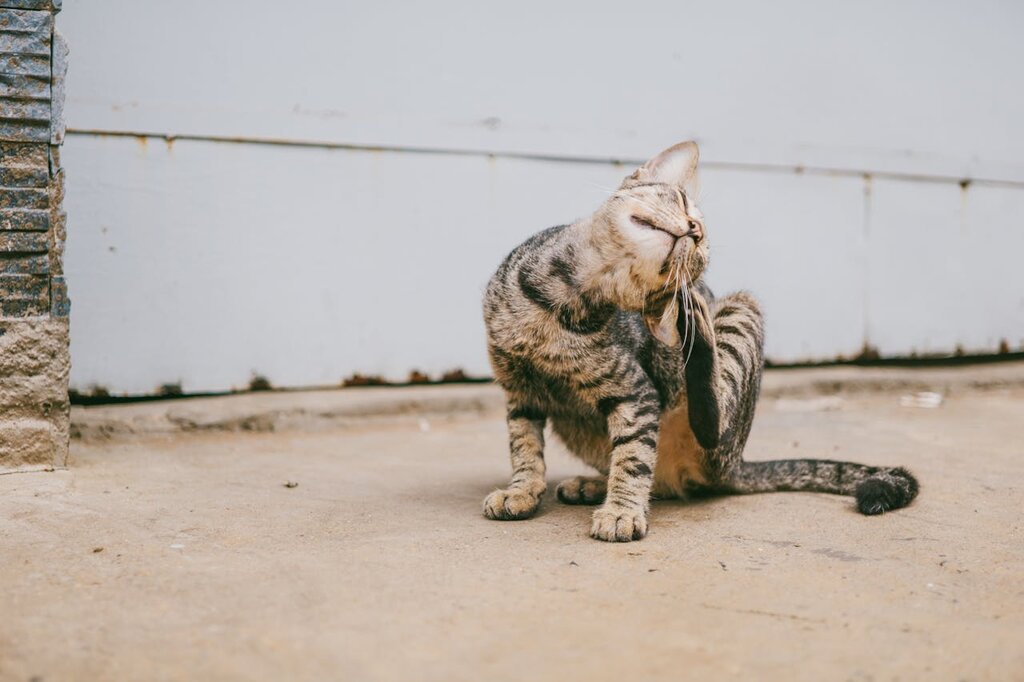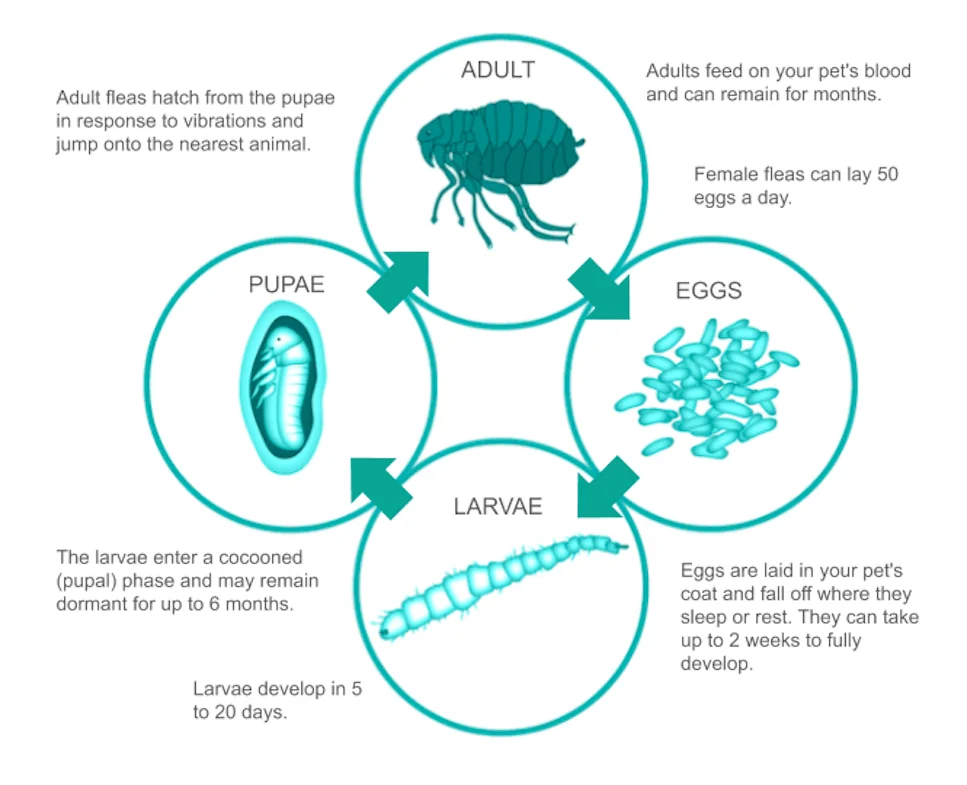Last Updated: 05/06/2025
How To Treat Cat With Fleas
Learn how to get rid of your cat's fleas for good with our vet authored guide.
Author: Dr Teagan Lever BVSc (Hons)
Reading Time: 23 minutes - medium read
Cats tend to be quite thorough in grooming themselves, which may result in flea infestations going unnoticed and untreated. Fleas are not only irritating to your prized feline, they can also cause flea dermatitis resulting in hair loss, sores and crusty bumps.
While failing to keep your cat's flea treatment up to date is likely to result in an unhappy, itchy kitty, it can also result in an infestation breaking out in your home. If this has happened to your house, do not fret. You can be rid of the fleas yourself without the need for calling in the exterminators.
Signs of flea infestation in cats

Often pet parents are surprised to learn that their cat has fleas. Because cats are such thorough groomers, it is possible for them to have signs of flea infestation without fleas being readily visible in their coat. Some common signs of flea infestation in cats include:
- Scratching and grooming more than usual
- Hair loss or thinning
- Formation of crusts and scabs on the skin
- Flea 'dirt' present in the coat, particularly in harder to reach places like around the base of the tail
Left untreated, heavy flea infestations can result in anaemia from chronic blood loss. Fleas can also transmit parasites and serious bacterial infections which can affect both pets and people, including Bartonella henselae and even Yersinia pestis, also known as plague!
How to tell if your cat has fleas
If you suspect your cat may have fleas, there is a handy trick that vets use to check, all you need is a fine tooth comb and a piece of damp paper towel. Use the comb to pick up any 'dirt' that you are able to find in your cat's coat, and then wipe it onto the damp paper towel. If the paper towel stains a reddish-brown, rusty colour, it's an indication that the substance is flea 'dirt' (faeces) containing blood. If flea dirt is present, your cat definitely does have fleas.
The flea lifecycle

95% of the flea lifecycle actually occurs off your pet, which means that any adult fleas you are seeing are just the tip of the iceberg.
- Adult fleas live on the pet, feeding on blood and laying eggs in the fur.
- Flea eggs drop off in areas where your pet sits or sleeps and hatch into a larval stage.
- Flea larvae burrow down and then encase themselves in a cocoon to become the pupal stage.
- Flea pupae can lie dormant for up to 6 months! Once stimulated by vibrations and movement nearby, the baby flea hatches from the cocoon and jumps onto a nearby pet, completing the whole annoying cycle.
When a female flea lays up to 50 eggs a day, it means that one flea can become one million fleas in as little as 6 weeks! Feeling itchy yet?
How to get rid of fleas
To successfully get rid of fleas, you need to do more than just kill the fleas on your pet. In order to prevent your pet being reinfested, it is critical to completely break the flea lifecycle. This is why just using a short acting flea shampoo or spray alone will not be effective.
Use flea prevention year round
There are loads of super effective flea treatments for cats which can be used to both treat pre existing flea infestations and prevent them from recurring. Depending on where you live and the other preventative products you use, you may want to go with a flea only product or a combined product which covers ticks or worms as well.
Remember that the pupal stage of the flea lifecycle can remain dormant in the environment for up to 6 months. This means that juvenile fleas may continue to emerge in the environment and reinfest your pet for a few months after you start treatment. So long as your pet has flea prevention on board, these baby fleas should die soon after coming in contact with them.
Treat all pets in the household
If you have multiple dogs or cats at home, every pet needs to be treated with an appropriate flea prevention product, even if they do not appear to have a flea infestation. This is essential to breaking the flea lifecycle, as untreated pets may continue to bring fleas and flea eggs into the home environment.
Treat the environment around you
Flea eggs, larvae, pupae and adult fleas will drop off your pet into other areas of your home. Materials like bedding, toys and carpet are ideal living areas for the flea family. If your cat is suffering from fleas, about 95% of the total flea problem is likely to be in your house rather than on your cat.
Treating the environment, as well as your pet, will wipe out the infestation much quicker. Gather all of your pet's bedding and material toys and place them in your washing machine on a hot wash (60°C) with washing detergent. If you have a dryer, putting them on a hot drying cycle is also recommended. A thorough vacuum or steam clean of carpets and rugs is also important, focusing particularly around the areas where your cat sleeps, and also behind and under furniture.
Some people opt for flea bombs to help to kill the parasitic visitors in their home. If using any flea bomb or spray product, always be cautious to follow the directions closely and remove your cat from the area being treated for at least the minimum recommended time. Many environmental flea treatments, including flea bombs, can be highly toxic to cats.
Safety considerations
While treating your cat for fleas is important, there are some safety aspects you should keep in mind before you administer any medications:
- Never use dog medications on your cat! Using dog specific medications on your cat can kill them or cause severe health concerns requiring hospitalisation
- If you have both dogs and cats in your house, do not treat your dogs with any product labelled as dangerous for cats.
- When applying a topical treatment to your cat, do not allow them or another cat to groom the area until the fur is completely dry
- Weigh your cat so that you can choose the right sized dose
Top flea treatments for cats
Flea treatment FAQs
Keep your cat healthy and happy by keeping their flea treatments up to date all year around. Your family, and household, will benefit immensely from diligently treating against this common bloodsucking parasite, which has the potential to make everyone's life miserable.
Remember to always follow the label as directed when it comes to medication and flea bombs. For example, you must never use a dog flea medication on your cat unless it is approved by the manufacturer for use in both species.
For best results, treat the environment and any other pets you own. Using a flea treatment on your cat will eventually rid your house of fleas however depending on the severity of the infestation, this could take a couple of months.
Further Reading
History
Our experts continually monitor the health and wellness space and we update our articles when new information becomes available.
Mon Mar 17 2025
Edited by Dr Teagan Lever BVSc (Hons)Dr Teagan Lever BVSc (Hons)
Head Veterinarian, BVSc (Hons)
Pet Circle's Head Veterinarian, Dr Teagan graduated from the University of Queensland in 2010 and went on to work in small animal and mixed practice in various locations around QLD & ACT before joining Pet Circle in early 2016. Dr Teagan has special interests in dermatology, nutrition and preventative health care. She feels privileged to witness the special bond people share with their pets on a daily basis and enjoys forming lasting relationships with pet parents and their fur children.

